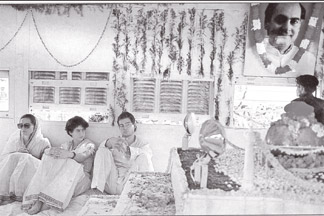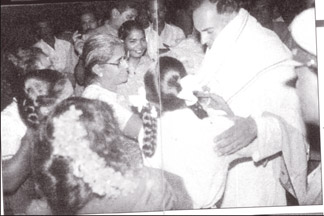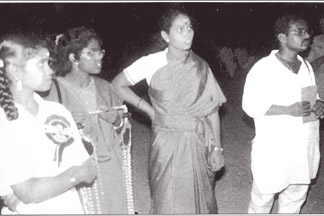LTTE, the monster that gobbled Rajiv
The family of the victims killed along with the former Indian
Prime Minister Rajiv Gandhi demanded that Murugan, Santhan and
Perarivalan should be hanged, the Indian Express reported. The
latest demand came after the clemency plea for the three death row
convicts in the Rajiv Gandhi assassination case grew louder. The
family of victims, joined by a large numbers of Indian Congress
workers, sat on a day-long fast opposing the clemency for the three
convicts. Former Union Minister EVKS Elangovan and other Congress
leaders also participated in the fast.
The Tamil Nadu Assembly on August 30 had passed a “unanimous”
resolution requesting the President to reconsider and commute the
death sentence awarded to the three convicts. The Madras High Court,
too, on the same day stayed the execution of the accused for eight
weeks, which was earlier scheduled for Friday. The three are
currently lodged in Vellore Jail, according to the Indian Express
report.
By P. Krishnaswamy

A family’s muted grief.

Dhanu waits for her chance, flowers in her hair, minus shoulder
bag and an unidentified hand placed on her back. |
Early days: Steel-helmeted, stern looking security men, with
machine-guns at the ready, were guarding the Colombo High Court premises
at Bullers Road (later named Bauddhaloka Mawatha), with some of them
positioned even at distant rooftops, when the trial-at-bar inquiry on
the “Neerveli Murder and Robbery’” came up for hearing before High Court
Judge C.L.T. Moonamale from the first week of January 1983. Tamil Eelam
Liberation Organisation (TELO) leaders Kuttimani, Thangavel alias
Thangathurai, Sivasubramaniam Sellathurai alias Thevan, Sivapathan
Master and Nadesuthasan were the accused in the case. That probably was
the first case against terrorism and terrorists tried under the
Prevention of Terrorism Act (PTA) in a Sri Lankan Court.
Senior police and army officers, finger-print experts and government
analysts were summoned as prosecution witnesses during the Court
proceedings. A tense situation emerged every time the heavily-guarded
accused who were in detention under the PTA were brought to the Court
and taken back in a prison bus. What also unfolded in the Court was that
the accused, hailing from Velvettithurai, the birthplace of Velupillai
Prabhakaran, were professional smugglers.
Senior Counsellor Nadesan Sathyendra assisted by a team of senior
counsellors, including G. Kumaralingam, appeared for the defendants
while Deputy Solicitor General Sunil de Silva, senior counsellors Mohan
Peiris, the outgoing Attorney General, and other state counsellors
appeared for the prosecution.
Rarely any relatives or friends of the defendants came to see the
court proceedings either because they were not allowed or they did not
want to be seen as relatives of suspects in a PTA case. But the first
accused Thangathurai’s wife, an Indian national from Tamil Nadu, was
there in the Court with her child , a boy aged about four, to see the
proceedings. The writer who was covering the proceedings as staff
reporter for a Tamil-language daily observed that the woman was very
emotional, shedding tears every time the suspect was examined and
cross-examined, and she also talked to him approaching the dock during
court adjournments. It was rather touching to see the small kid trying
to embrace and kiss his father.
While the verdict in this case was still pending, what happened to
the accused is part of the darkest pages of the country’s history. In
the 1983 “Black July” communal violence, let loose under the patronage
of the then UNP Government headed by President J.R. Jayewardene, over
one thousand Tamils were killed by wild mobs, many times that number
were grievously wounded and several thousands were reduced to utter
destitution having lost everything they owned.
The communal frenzy spread to the high security Welikda prison and 35
Tamil prisoners kept in detention there under the PTA, including the
five defendants, were killed.
Consequently nearly 80,000 Tamils fled to camps that came up in
school buildings and other public buildings. A good percentage of them,
who feared for the safety of their lives and their families, were
provided passage and asylum by India in its Tamil Nadu state. Hundreds
of Northern Tamils also huddled together in boats and started sailing to
Tamil Nadu marking their first mass exodus across the Palk Strait.
During the onslaught on terrorists that lasted over two decades, the
LTTE permitted hundreds of thousands Northern Tamils to flee to Tamil
Nadu in boats and fishing vessels and, on many instances, the exodus was
organised by the LTTE in a systematic manner.
What was evidenced by the presence of the Tamil Nadu spouse and the
child of one of the accused in the Colombo High Court was that
inter-marriages, smuggling operations and other illicit activities
between Tamil Nadu and the Northern Sri Lanka have been taking place for
quite some time,unchecked by the two governments, further strengthening
the interaction between the two communities.

Dhanu, the 25 year-old belt-bomb woman, awaits her moment of
destiny, a cool figure. She is positioned between 15-year-old
Kokila and 35-year-old Latha Kannan, whom she evidently knows.
Standing slightly away is the ‘one-eyed’ Sivarajan, the back-up
assassin. |

Subha and Nalini, dressed stylishly in silk sarees, are seated
at the back of the women’s section. |
The relations so fostered and encouraged under the patronage of
political hardliners seeking political mileage have now assumed such
incendiary dimensions across the Tamil Nadu state that a cross section
of the people and their political leaders have demanded the commutation
of the death sentence on the three convicts, two of them hardcore
LTTEers, in the Rajiv Gandhi gruesome assassination case. Many of them
have expressed solidarity with the cause of the LTTE, the terrorist
outfit that brutally killed their charismatic national leader, perhaps
because public memory is short or that rousing communal sentiments is
the only way out for their political existence.
Two LTTE members V. Sriharan alias Murugan, T. Sathendraraja alias
Santhan and their Indian accomplice A.G. Perarivalan alias Arivu who
were convicted of having plotted the assassination of Rajiv Gandhi were
sentenced to death by hanging and the executions were to be carried out
yesterday, September 9.
Their mercy petitions were rejected by the President of India. But
they got a reprieve two weeks ago with the Madras High Court staying the
executions for two months, after a petition was filed on their behalf.
It was reported that slogans were raised and crackers were burst in the
court premises when the Court order was issued.
Rajiv Gandhi, India’s Prime Minister from 1984 to 1989 and the third
from his family after grandfather Jawaharlal Nehru and his mother Indira
Gandhi to be the country’s prime minister was blown to smithereens on
the night of May 21, 1991 by an LTTE suicide woman during the last leg
of his polls campaigns at Sriperumbudur , a small town 50 km southwest
of Chennai.His face was ripped off. Shocked survivors recognised his
body from the white sneakers which he was wearing.
The bespectacled LTTE suicide woman, Dhanu, clad in salwar kameez was
concealing her explosive and killer pallets in a belt. She disguised as
a well-wisher waiting to greet and garland Rajiv Gandhi.
Fifteen people including the suicide woman, another accomplice
Haribabu, who was posing off as a photographer, and her associates in
Chennai Latha Kannan and Kokila were also killed. Haribabu’s camera,
capturing the last moments of Rajiv Gandhi and others at the meeting,
remained a mute witness near its temporary owner’s shattered body.
Rajiv Gandhi’s grotesque assassination stunned India - and the world.
Later developments and investigations proved that the LTTE was behind
the repulsive deed.
Indian sleuths built a watertight case, naming 41 people as
conspirators in the assassination. Twelve of them committed suicide to
avoid arrests, mostly by consuming cyanide.
The one-eyed Sivarasan, the notorious LTTE assassin who had
manoeuvred the Rajiv Gandhi assassination plot in Tamil Nadu and his
LTTE accomplice Subha committed suicide when the Indian commandos
tracked them to a hideout far away from the assassination site.
Nalini, wife of one of the convicts Murugan, who watched with an
accomplice Gandhi die, was arrested, tried in court and is presently
serving life imprisonment. |

